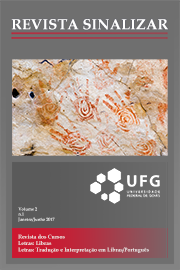Literary tales for children as a teaching resource in the deaf student imaginary construction
DOI:
https://doi.org/10.5216/rs.v2i1.36158Keywords:
Language, Sign language, Children's Literature, Reading, Deafness.Abstract
Deaf children learn in an analogous way to hearing children. The medium in which the child is inserted influences his capacity for communication and language, which can be facilitated and enriched by the offer of children's literary tales. The possibility of early communication of the hearing child makes it more cognitively advanced in relation to the deaf child because the communicative deficits of the deaf make learning difficult. The children's literary text can be a didactic resource to incite the imagery of the deaf, leading him to create, signify and re-signify situations and emotions, enriching his vocabulary. The aim of this article is to analyze the importance of children's literature as a didactic resource in the construction of the imaginary of the deaf individual, based on the reflections of theorists such as Piaget, Chomsky and Vygotsky.
Downloads
References
BRASIL. Referencial Curricular Nacional para a Educação Infantil (RCNEI). Brasília: MEC/SEF, 1998.
CADEMARTORI, L.O.. O que é literatura infantil? 6. Ed. São Paulo: Brasiliense, 1994.
CHOMSKY, Noan. Language and Problems of knowledge: The Managua Lectures. Cambridge, MA: MIT Press, 1988.
COELHO, Nelly Novaes. Panorama Histórico da Literatura Infantil Juvenil. 4. ed. São Paulo: Ática, 1991.
HESSEL, C., ROSA, F., KARNOPP, L. B.. Cinderela Surda. Canoas: ULBRA, 2003.
KARNOPP, L. B.. Aquisição Fonológica na Língua Brasileira de Sinais: estudolongitudinal de uma criança surda. 1999. Tese (Doutorado) – Pontifícia Universidade Católica do Rio Grande do Sul, Porto Alegre, 1999.
_________. “Literatura Surda. Literatura, Letramento e Prática Educacionais Grupo de Estudos e Subjetividade”. ETD – Educação Temática Digital, Campinas, v. 7, n. 2, p.98- 109, jun, 2006.
LEBEDEFF, T.. “Reflexões sobre adaptações culturais em histórias infantis produzidas para a comunidade surda”. In: ORMEZZANO, G.; BARBOSA, M. (Org.). Questões de Intertextualidade. Passo Fundo: UPF, 2005, p. 179-188.
PIAGET, J.. Psicologia e epistemologia: por uma teoria do conhecimento. Rio de Janeiro: Forense, 1973. Revista Sinalizar, Goiânia, v. 2, n.1, p. 24- 34, jan. / jun., 2017 ISSN: 2448-0797.
QUADROS, Ronice. As categorias vazias pronominais: uma análise alternativa com base na alternativa com base na língua se sinais brasileira e reflexos no processo de aquisição. Dissertação de Mestrado, Pontifícia Universidade Católica do Rio Grande Do Sul, 1995.
_________. Educação de Surdos. Porto Alegre: Artes Médicas, 1997.
_________. “O ‘Bi’ em bilinguismo na educação de surdos”. In E. Fernandes (Org.). Surdez bilinguismo. Porto Alegre, RS: Editora Mediação, 2005, 26-36.
__________. Aquisição bilíngue intermodal: Libras e Português. In: 18º Intercâmbio de Linguística Aplicada, 2011, São Paulo: Caderno de Resumos, 2011.
_________ ; KARNOPP, L.. Língua de Sinais Brasileira: estudos linguísticos. Porto Alegre: ArtMed, 2004.
ROSA, F. Literatura Surda: Criação e Produção de Imagens e Textos. © ETD – Educação Temática Digital, Campinas, v.7, n.2, p.58-64, jun. 2006.
________; KARNOPP, L.. Adão e Eva. Ilustrações de Maristela Alano. Canoas: ULBRA, 2005.
________; KARNOPP, L.. Patinho Surdo. Ilustrações de Maristela Alano. Canoas: ULBRA, 2005.
SILVEIRA, C. H., ROSA, F., KARNOPP, L. B.. Rapunzel Surda. Canoas: ULBRA, 2003.
SKLIAR, C.. (Org.). A Surdez: um olhar sobre as diferenças. Porto Alegre: Mediação, 1998.
SOUZA, R. M. de. Que palavra que te falta? São Paulo: Martins Fontes, 1998.
STROBEL, Karin. As imagens do outro sobre a cultura surda. Florianópolis: Editora da UFSC, 2009.
VYGOTSKY, L.S.. O desenvolvimento psicológico na infância. São Paulo: Martins Fontes, 1998.
Downloads
Published
How to Cite
Issue
Section
License
Copyright

This work is licensed under a Creative Commons Attribution-NonCommercial-NoDerivatives 4.0 International License.
Autores que publicam nesta revista concordam com os seguintes termos:
Autores mantém os direitos autorais e concedem à revista o direito de primeira publicação, com o trabalho simultaneamente licenciado sob a Creative Commons Attribution License que permitindo o compartilhamento do trabalho com reconhecimento da autoria do trabalho e publicação inicial nesta revista.
Autores têm autorização para assumir contratos adicionais separadamente, para distribuição não-exclusiva da versão do trabalho publicada nesta revista (ex.: publicar em repositório institucional ou como capítulo de livro), com reconhecimento de autoria e publicação inicial nesta revista.







